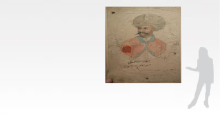
ATTRIBUTED TO HULAS LAL, PATNA, CIRCA 1840
Inscribed 'Haidar Naik (Ali) of Madras/ Father of/ Tipu Sultan' and bearing an illegible exhibition label on the cover (front); and inscribed 'Prepared by Bl. Hoolas Lall of Patna (Lodicatra) on the cover (back); inscribed in Persian and Devnagari at the lower centre and lower right respectively
Watercolour on paper pasted on paper
Image: 7.25 x 4.25 in (18.3 x 11.1 cm)
NON-EXPORTABLE REGISTERED ANTIQUITY
PROVENANCE
The artist's family
Thence by descent
Company School Painting
The Company School of painting refers to paintings made in British India in the late 1700s and early 1800s. With the British East India Company expanding its reign over the South Asian subcontinent, a large number of its employees from England were posted in India. As they travelled extensively across India, they were taken in by its flora and fauna, ancient monuments, local people and their lifestyles. Some employees hired local artists to undertake precise documentation, and trained them in the European norms of perspective, scale and proportion, and shading, including a muted colour palette. The artists combined these new techniques with the ornamentation and detailing of Mughal painting traditions to give rise to a hybrid style. Company School paintings are identifiable by their muted watercolour tones and perspective construction that is markedly different from miniature paintings. Employees of the British East India Company often sent these paintings of their new environment back to family and friends in England.
Company School painting developed in cities which were major political and economic centres for the British with, Calcutta and Patna being the most significant. English art historian Mildred Archer notes that by 1800, Patna was an important administrative headquarters which was home to European judges, barristers, lawyers, chaplains, merchants and doctors, as well as wealthy Indian landowners. Eminent artists such as Bani Lal, Hulas Lal, and Shiva Lal received patronage from the city's wealthy residents and further enhanced its reputation as a centre for artistic development. Their paintings document animals, locals and their attire, as well as quotidian scenes such as people gathered at a railway station or women on their way to temples. Facial features and contouring show a great degree of finesse, while perspective and shading are in the European style. Works by these three artists are among the Company School paintings in this catalogue.
Haidar Ali Khan
Father of Tipu Sultan, Haidar Ali Khan was an astute military commander and the ruler of Mysore from 1761 to 1782. He began his career as a soldier in the service of the King of Mysore. Impressed with Haidar Ali's loyalty and valour, the king appointed him Commander-in-Chief of the Mysore army. Haidar Ali's ambitions were augmented by his exemplary skills as a strategist. "Cool and sagacious in war-time, he excelled in cavalry tactics and seemed to possess by intuition the knowledge of how to launch his horsemen with the greatest impact on the enemy." ("Haidar Ali and Tipu Sultan: A Brief Profile", Shodhganga, online) In 1761, amidst mounting tensions between the Kingdom of Mysore and the Marathas, the British and the Nizam of Hyderabad, Haidar Ali gained control as the Sultan of Mysore.
Under his reign, the Kingdom of Mysore grew to become a formidable economic and military power. "In the course of a few years it absorbed all the petty principalities lying beyond its original frontiers and came to extend up to the river Krishna in the north and the Malabar Coast in the west. Such a rapid expansion was made possible by a variety of factors - the remarkable abilities of Haidar both in war and in diplomacy." (S P Sen quoted in Shodhganga) Between 1771 and 1782, Haidar Ali was successful in capturing Coorg, Trichur Cochin and Mahe, and assumed total control over regions between the Coromandel and the Malabar Coasts.
Haidar Ali had several military accomplishments to his credit. Among the most well-known was his development and use of sophisticated military technology. In the Anglo-Mysore Wars of the late 18th century, Haidar Ali deployed rockets with iron casing which he and Tipu Sultan had developed together. These Mysore rockets were instrumental in repelling the British, and served as a model for rockets developed by the British for the Napoleonic Wars of 1803-1815. Haidar Ali died in 1882, and was buried by Tipu Sultan at the Gumbaz at Seringapatam.
Th is portrait of Haidar Ali is attributed to the master artist Hulas Lal of the Patna School. It captures the characteristic military stance and demeanour of the ruler. In keeping with the norms of Company School paintings, there is an understated precision and restraint in this striking rendition.
Other similar works in:
this auction
|
entire site

Lot
20
of
87

CLASSICAL INDIAN ART
10-11 APRIL 2018
Estimate
Rs 3,00,000 - 5,00,000
$4,690 - 7,815
Winning Bid
Rs 4,36,992
$6,828
(Inclusive of Buyer's Premium)

Size Size

Height of Figure: 6'